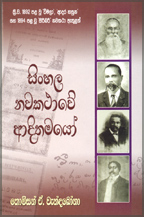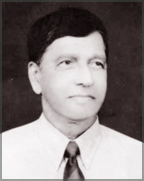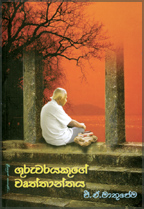|
dailynews |
|
|
|
|
|
OTHER LINKS |

|

|

|
|
Focus on pioneers of the Sinhala novelSinhala Nawakathave Adithamayo Author: Thompson A. Van de Bona Sarasavi Publishers, Nugegoda 176 pp Price Rs. 225 Review: R. S. Karunaratne FICTION: Thompson A. Van de Bona of Parisiye Kathawak fame is perhaps one of those unsung, unrecognized authors among the Sinhala literati. Although he has written a number of novels including Muhudin Etharata, Viya Sidurin Sasara Ditimi, Semada Samarami Sudu, Thada Ima and Ashavo, his work has not been properly assessed by critics. However some of his recent books in the form of translations including Deriyakage Dinapotha and Umathu Mahallakuge Dina Satahan (the diary of a mad old man) were successful transcreations.
The present work - Sinhala Navakathave Adithamayo - is a research into the contributions of four pioneers of the Sinhala novel. Although the Sinhala novel was not a popular genre in its embryonic stage, Bentota Albert Silva, L. Isaac de Silva, Piyadasa Sirisena and Alutgamage Simon de Silva have made a concerted attempt to popularise the novel as a form of literature. Van de Bona contends that many critics have attempted to comment on the Sinhala novel even without reading some of the works by Bentota Albert Silva. It is strange but true that some of novels - Wimala, Adara Hasuna and Siribari are not readily available to the Sinhala reader. Due to the author's attempts, these three short novels have been included in the book under review. L. Isaac de Silva's Vasanavantha Pavula - Kalakanni Pavula was first serialised in his Ruwan Maldama. The novel was meant to popularise religion. Van de Bona has given the summary of the novel. He also traces the similarities between Isaac de Silva's novels and John Bunyan's The Pilgrim's Progress, The Life and Death of Mr Badman and the Holy War.
Bentota Albert Silva seems to have a greater influence on the Sinhala novel. He was the first author to introduce his stories as "Albert's Novels". Being well-versed in English and Latin he had access to classics and semi-classics. He translated the Arabian Nights into Sinhala way back in 1892 and later wrote his short novel 'Wimala'. Piyadasa Sirisena (1875-1946) made it a point to popularise Buddhist principles in his novels. He condemned the Western culture in most of his novels including Vasanavantha Vivahaya. Van de Bona is of the view that Piyadasa Sirisena's novels were serialised before Simon de Silva's "Meena" supposed to be the first Sinhala novel. "Meena was a big hit at the time going by the reviews published. Towards the end of the book Van de Bona makes a case for Albert Silva's Wimala as the first Sinhala novel. However this may not be acceptable to those critics who believe that Meena was the first Sinhala novel. Taken as a whole, Thompson A Van de Bona has made a bold attempt to trace the origins of the Sinhala novel. The inclusion of the four novels has enhanced the value of this book. Meanwhile, Sarasavi Publishers has done a good job in presenting the book in a pleasant format. Readable autobiographical novelGuruwarayakuge Vruthanthaya Author: G.A. Mathupema Publisher: Piyasara Publishers, Kalutara Price: Rs.125 Review: Sarasi Wettimuny FICTION: Autobiographical novel is a genre that is not quite common in Sinhala literature. Of course, there are autobiographies in Sinhala, some of them are really very fine. But in the continent, autobiographical novels are very common and one is reminded of writers such as Truman Kapote and Norman Mailer, who have successfully transformed their life stories into novels.
The recently released autobiographical novel "Guruwarayakuge Vruthanthaya" by G.A. Mathupema is a fine example for an autobiographical novel which has woven the true facts of his life artistically into a prose poem. Being a veteran writer and a good teacher Mathupema has entered the field of journalism half a century back and he has to his credit a number of novels, short stories and books on literary criticism and psychology. The background of this novel is the society in transition since the late nineteen thirties. The school life in Sri Lanka during colonial days before independence has been well depicted in this novel. Socio-political revival in 1956, insurgent movement in 1971, racial riots in 1983, the black July, macabre killings and human torture in 1988 have formed the milieu of this novel. A teacher's reaction to the social changes that have taken place in eight preceding decades have been transmuted into a novel. Towards the end of the novel, its tempo quickens, disturbing even the tenor of the novel. The writer's vivid descriptions about his childhood, youth and career experiences as a teacher are highly sensitive. The rural setting of his childhood was well enjoyed by the writer, his close connections with his family members specially grandfather (Atha) and grandmother and his attitudes towards nature, how he admires nature are clearly depicted through various incidents. One who reads the novel will surely be impressed with the nostalgic feelings of the writer in looking back towards his past life. During Mathupema's school days he had taken the leadership in forming a small library called 'Rasika Gula'. Through his attractive language style, the writer has successfully presented how they managed to buy books for their small library in various ways. The innocent mischievous activities as a school boy are quite nicely portrayed in this novel. The incident where the writer used his school fees given by the father for buying "Sinhala Sahithyaye Nagima" is an interesting episode, the writer has recollected the incident which caused him troubles in finding money to pay back his school fees. There are also a few other instances where the writer's love of books is indicated. He has spent his money for buying newspaper 'Nidahasa' published by poet Somaweera Chandrasiri and other magazines such as Heladiwa, Lanka, Kasaya, Nuwana edited by Manawasinghe. Indeed, we realize that the writer is a great lover of books and lives in the world of books. There are certain references to some books such as 'Crime ad Punishment' of Dostoevsky, Maxim Gorky's 'My Universities', Sumerset Maugham's 'Summing Up' in relation to the writer's feelings. Here we see how Mathupema has gone to the depths of these books. It should be noted how he was deeply shocked after reading 'Crime and Punishment'. He had sort of marooned between his beliefs and the actual happenings in the world. The readers of this autobiographical novel will understand how one can awaken one's critical thinking in reading books. "Guruwarayakuge Vruthanthaya" has covered all stages of one's life. Mathupema's experiences in childhood, youth, career of teaching and his married life, children and his overall general view point towards life is quite impressively presented in this autobiographical novel. Characteristic feature of this novel is the sympathetic tone running through the entire work. The writer never speaks ill of those people who have been unkind to him in certain occasions of his career. What is most impressive about this novel is the vein of pathos of the life of the protagonist running throughout the entire work 'The still sad music of humanity'. Compulsory reading for those seeking adventureDeception Point Author: Dan Brown Gorgi Books 585 Pages Review: Jagath Savanadasa FICTION: Deception Point yet another thrilling novel by Dan Brown did not cause the controversy and the protests that the Da Vinci Code his other novel led to in quite a few parts of the world. Deception Point is a different genre of a novel to the Da Vinci Code. In the latter Brown led his vast and global readership on an exciting yet controversial journey, in the course of which he made daring incursions and revelations in regard to little known aspects of Catholicism. He also delved into, several Institutions, rituals, customs, and practices connected to the religion. For example, the Opus Dei whose long existence seems not widely known. Unfortunately in the creation of a complex novel Brown crossed accepted boundaries of literary endeavour. His fictional twists and imaginative diversions although part of the privileged repertoire of a novelist did not go down well with some readers. It indeed hurt their religious sensitivities. And this is where Brown is believed to have erred to an extreme degree. Religion is a subject close to the hearts of people. Any questionable versions of age old religious practices and beliefs could evoke the wrath of people. Salman Rushdhie hurt the sensitivities of the followers of Islam and had to go into hiding for several years to protect himself from the FATWA (death sentence) imposed by the former Iranian President. Similarly senior readers will recall following Bhavatharanaya, Martin Wickramasighe was subjected to extreme criticism because he had commented on the Life of the Buddha. Quite apart from all this Deception Point confirms Brown's creativity and versatility and his research skills. In this novel Brown's insightful scientific knowledge especially his knowledge of the undiscovered depths of the ocean fascinates the reader even without the exciting plot that he has created. To use these as a platform to launch a riveting tale is what elevates Brown to the incomparable league of a selected few like Michael Crichton in today's world of fiction. In contemporary times these two novelists stand apart from their peers purely on their ability to present diverse backdrops and themes. Thus Brown's Da Vinci Code is different to Deception Point as chalk is to cheese. Similarly Crichton's Congo to his Digital Man. At the centre of the Deception Point is the discovery of a 300-year-old meteorite buried in the remote Arctic. The United States more specifically the National Aeronautics and Space Administration who are eternally on surveillance worldwide makes this astonishing discovery which would have great implications all over. From this point onward the story revolves on intrigue and in perpetuation of an incredible hoax - its deception at the highest levels of the US administration. In the meantime the President of the US is facing a crisis. His popularity is on a steep downward trend. The critics often cite NASA in attacking his image. The principal adversary in this story is contesting the upcoming Presidential Election and he makes relentless attacks on the incumbent using NASA's spending as a principal weapon. The vast expenditure that NASA incurs in the pursuit of other planets and galaxies seem to have aroused the conscience of the electorate. The President's opponent points out that such extravagant spending could instead be used more wisely and on more worthy causes. Deception Point is compulsory reading for those who seek adventure and excitement. Stay healthy without drugsMiracles Through Pranic Healing Author: Master Choa Kok Sui Review: Aditha Dissanayake HEALTH: Whenever you suffer from a headache, backache, a sore throat or toothache, have you wished you knew what to do to cure yourself instead of rushing to the doctor or gulping down a handful of drugs? Here is an end to such wistful thinking. Readers of Miracles Through Pranic Healing can now heal themselves and others simply by following the step by step instructions given by Master Choa Kok Sui, which can be easily understood, acquired and practised with no drugs and often "no touching". "In an era when, in spite of their stunning achievements in medical science, when even the West has begun to seek traditional ailing practices of the East (Ayurvedha, Yoga, Acupuncture, etc) Pranic Healing, based on the ancient science and art of non-touch and no-drug healing is now being practised all over the world including the USA, Canada, South America, etc", says Deva Somasundaram of the Pranic Healing Foundation, Sri Lanka. PranaExplaining the meaning of Prana, Somasundaram says, "The word Pranic is derived from the Sanskrit word "Prana" which means "Life Force or Life Energy". It is this life force that keeps the body alive and healthy. Prana is limitless and universal and can be quite easily transferred to a patient to bring about healing whenever required." Where do you find this prana? From the sun, the air around you and the earth. Solar prana can be obtained by staying in the sunlight for ten minutes or by drinking water that has been exposed to sunlight. Air prana can be absorbed by deep, rhythmic breathing while in order to absorb ground prana you should walk barefooted in order to allow the soles of the feet to absorb this energy from the earth. Certain trees are also said to exude excess prana which could be absorbed by tired or sick people when they lie down or rest beneath these trees. ResultsThough this kind of healing happens automatically the rest has to be learnt. Master Choa Kok Sui introduces a simplified and mechanistic approach to Pranic Healing but says that at the same time the healing is also spiritual. "It is mechanistic in the sense that all that one has to do is to follow instructions step-by-step and the predetermined results will follow. It is spiritual in the sense that by praying or by invoking, one becomes a divine healing channel". Writes Master Sui. The book claims to teach within a week or two, how to heal simple ailments; and within a month or two how to heal difficult cases. "One does not have to spend ten to twenty years just to learn how to perform paranormal healing. Assures the author." Neither does one need to have any "special inborn healing power" nor be a clairvoyant to heal. All that one needs is the willingness to heal and to follow the instructions given in this book". IntelligenceIn other words, if you have an average intelligence, an average ability to concentrate, an open but discriminating mind and a certain degree of persistence you will soon be curing your own ailments and of those around you, or of those who are even hundreds or thousands of miles away. "Learning Pranic Healing is easier than learning to play the piano or painting. It is as easy as learning to drive.", says Master Sui,but, he adds as everything else in the world one requires practice to achieve a certain degree of proficiency. So, here's bidding goodbye to doctors and medicine. Here's to good health through Pranic Healing. The book is published by World Pranic Healing Foundation 21/10, A. Ram Villa, Craig Park Layout, M.G. Road, Bangalore - 560001 E-mail [email protected] wphf-india@ hotmail.com Origin and contribution of Javanese in Sri LankaSaga of the exiled Royal Javanese unearthed Author: Tuan Arifeen Burah Vijitha Yapa Bookshop, Colombo 151 pp. Price Rs. 250 Review: T. Aniff Ahamed MALAYS: The Malays in Sri Lanka are the descendants of the kings, queens, princes and princesses, noblemen, dignitaries, artists, craftsmen, Commanders and their retinue, who were part and parcel of the sovereign, exiled by the Dutch. A hereto unknown factor, perhaps buried in the sands of time, has been unravelled by the author T. Arifeen Burah a senior professional in land surveying and land economics. He has delved into old records at the Archives and other sources to gather the relevant information. The book covers a period of 156 years.
This book has been made possible after a great deal of painstaking research Dutch Professor Vanden Belt of the Lieder University of Holland played a major role in having given his valuable time and expertise to the translation in to English from the Romanised Dutch records. The Assistant Archivist Mrs. Dias has also helped the author. This aspect of it had been the missing link that has prevented the narration of this epic story by other historians. The saga unfolds when the exiled Javanese Prince Amankoeratte of Batavia and the royal retinue arrived in Sri Lanka. Developing and expanding the base of spices and commodity trade between Sri Lanka and Batavia has been his direct responsibility. Entrustment of these duties to him by the Dutch rulers highlights the capacity and the respect given to the royal party. The book gives information of the forefathers of the author and their contribution to many aspects of commerce and life in the wider community in Sri Lanka. Much emphasis has been laid on the Prince Amankoeratte. In trying to establish the genealogy of the Javanese (now termed Malays) in Sri Lanka to their ancestors he has not only obtained information from archival records but has also visited many Malays in obtaining valuable data which had been passed down to them by their great grandfathers. With the invasion of the British to Sri Lanka (Ceylon) communication between the Dutch in Java and the exiles comes to an abrupt end when the change of names took place to conceal their royal identity when taking the "Oath of Allegiance" to serve under the British when Ceylon ceded to the British. Most of the Javanese names therefore were Anglicised for easy pronunciation by them. With great delight I recommend this book to all Sri Lankans who should know the origin and the contribution made by the Javanese (now classified as Malays). The author avers that with globalisation an individual will be identified by a numeral and a name is no longer relevant. I hope that his research will be used in preserving one's identity. |













